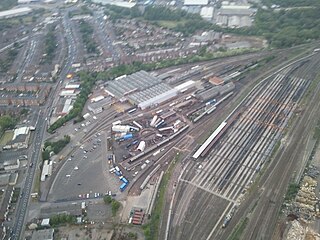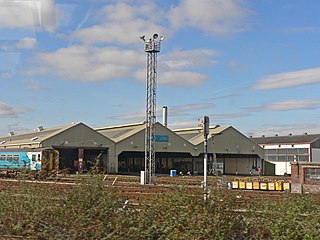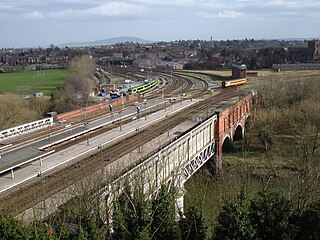
The Barry Tourist Railway is a railway developed to attract visitors to Barry in the Vale of Glamorgan, South Wales. It is a key element of the Barry Rail Centre which also includes engineering and training facilities.

A motive power depot (MPD) or locomotive depot, or traction maintenance depot (TMD), is where locomotives are usually housed, repaired and maintained. They were originally known as "running sheds", "engine sheds" or just "sheds". Facilities are provided for refuelling and the replenishing of water, lubricating oil and grease and, for steam engines, the disposal of ash. There are often workshops for day-to-day repairs and maintenance, but locomotive building and major overhauls are usually carried out at locomotive works.

Shrewsbury railway station is in Shrewsbury, Shropshire, England. Built in 1848, it was designated a grade II listed building in 1969.

The Shrewsbury and Birmingham Railway was authorised in 1846. It agreed to joint construction with others of the costly Wolverhampton to Birmingham section, the so-called Stour Valley Line. This work was dominated by the hostile London and North Western Railway, which used underhand and coercive tactics. The section between Shrewsbury and Wellington was also built jointly, in this case with the Shropshire Union Railway.

The Cambrian Coast Express is an old named passenger train of the Great Western Railway (GWR), and later British Rail, running from London Paddington via Shrewsbury to Aberystwyth and Pwllheli over the Cambrian Line.
The Wrexham and Minera Railway or Wrexham and Minera Branch was a railway line in North Wales between the city of Wrexham, the village of Brymbo where it served the Brymbo Steelworks, and the lead mines and limeworks at Minera. A further branch ran from Brymbo to Coed Talon, where it connected with lines to Mold. The system was constructed in several stages between 1844 and 1872, while the various lines making up the system closed in 1952, 1972 and 1982.

Birkenhead Dock Branch is a disused railway line running from the South junction of Rock Ferry, to the site of the former Bidston Dock on the Wirral Peninsula, England. The branch is approximately 4+1⁄2 miles (7.2 km) in length. Although called a branch, the line was accessible from both ends, from Bidston East junction and from Rock Ferry railway station. The former Mollington Street Rail Depot was branched into the line. A section of the line runs through Haymarket Tunnel and a low-level cutting through the centre of Birkenhead; visible from the road flyovers. The former Canning Street North signal box has now been demolished following fire damage, and the rails across the level crossing there have been removed due to the provision of cycle lanes on the roadway. The non-standard gates remain on the east side, but a fence has been erected on the other side despite the railway being officially out of use, rather than closed. Level crossings are also located at Duke Street and Wallasey Bridge Road. The railway lines are still partially intact.

Birkenhead Mollington Street was a former traction maintenance depot located at Mollington Street in Birkenhead, England, on the Birkenhead Dock Branch railway. Although never directly connected by rail, the depot was situated less than 200 m (660 ft) from Birkenhead Central railway station. The depot serviced steam and subsequently diesel locomotives until 1985, when it was closed and demolished. As of 2018, the site of the depot is still disused.

Old Oak Common TMD was a traction maintenance depot located west of London Paddington, in Old Oak Common. The depot codes were OC for the diesel depot and OO for the carriage shed. In steam days the shed code was 81A.

Bletchley TMD is a railway traction maintenance depot situated in Bletchley, Milton Keynes in Buckinghamshire, to the north east of Bletchley railway station, on a siding off the Marston Vale line. The depot is operated by London Northwestern Railway.

Laira Traction and Rolling Stock Maintenance Depot is a railway traction maintenance depot situated in Plymouth, Devon, England. The depot is operated by Great Western Railway (GWR) and is where their fleet of High Speed Trains are overhauled along with those belonging to CrossCountry. These will be withdrawn in 2023 but it will then become the principal depot for GWR's Class 802 InterCity Express Trains. Other trains visit for daily servicing.

Tyseley TMD is a railway traction maintenance depot situated in Tyseley, Birmingham, England.

Cardiff Canton TMD is a diesel locomotive traction maintenance depot in Cardiff, Wales. Its depot code is CF. It is operated by Transport for Wales. The depot is used by Transport for Wales fleet and some Cross Country Class 170s.

Penzance TMD, also known as Long Rock TMD, is a railway traction maintenance depot situated in the village of Long Rock east of Penzance, Cornwall, England, and is the most westerly and southerly rail depot in the country. The depot operator is Great Western Railway. The depot code is PZ.

Severn Bridge Junction is the area of railway lines just south east of Shrewsbury railway station, in Shropshire, England. It is controlled by a mechanical interlocked signal box of the same name, which is the largest operational mechanical signal box in the world. The Network Rail signalling area code is 'SBJ.'

Exeter Traction Maintenance Depot is a railway Traction Maintenance Depot situated in Exeter, Devon, United Kingdom and is next to the city's main St Davids station. The depot is operated by Great Western Railway and has an allocation of diesel multiple units.
The Newport, Abergavenny and Hereford Railway was a railway company formed to connect the places in its name. When it sought Parliamentary authorisation, it was denied the southern section, and obliged to use the Monmouthshire Railway between Pontypool and Newport.
The Crewe and Shrewsbury Railway was a railway company which was previously owned by the London and North Western Railway (LNWR), built to connect Crewe with the Shrewsbury and Hereford Railway which was jointly owned with GWR.

Oswestry railway station is a Grade II listed heritage railway station in Oswestry, Shropshire, England. It was closed when passenger services were withdrawn in 1966. The station building today is used as commercial premises although the Cambrian Railways Society are restoring it.
Carnforth MPD (Motive Power Depot) is a former London Midland and Scottish Railway railway depot located in the town of Carnforth, Lancashire, England.


















